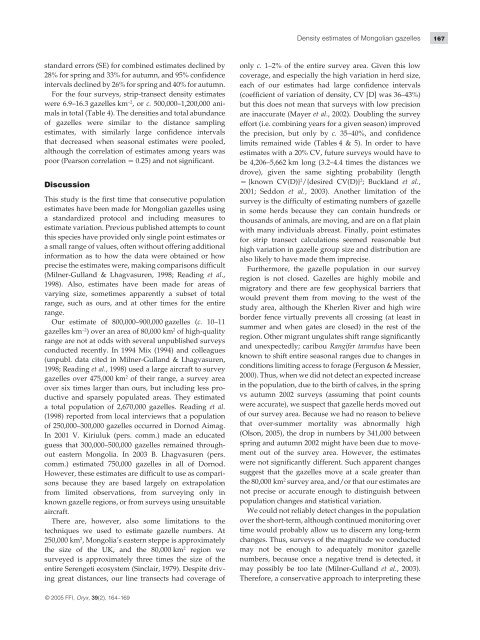Estimating the population density of Mongolian gazelles Procapra ...
Estimating the population density of Mongolian gazelles Procapra ...
Estimating the population density of Mongolian gazelles Procapra ...
Create successful ePaper yourself
Turn your PDF publications into a flip-book with our unique Google optimized e-Paper software.
Density estimates <strong>of</strong> <strong>Mongolian</strong> <strong>gazelles</strong><br />
167<br />
standard errors (SE) for combined estimates declined by<br />
28% for spring and 33% for autumn, and 95% confidence<br />
intervals declined by 26% for spring and 40% for autumn.<br />
For <strong>the</strong> four surveys, strip-transect <strong>density</strong> estimates<br />
were 6.9–16.3 <strong>gazelles</strong> km −2 , or c. 500,000–1,200,000 animals<br />
in total (Table 4). The densities and total abundance<br />
<strong>of</strong> <strong>gazelles</strong> were similar to <strong>the</strong> distance sampling<br />
estimates, with similarly large confidence intervals<br />
that decreased when seasonal estimates were pooled,<br />
although <strong>the</strong> correlation <strong>of</strong> estimates among years was<br />
poor (Pearson correlation = 0.25) and not significant.<br />
Discussion<br />
This study is <strong>the</strong> first time that consecutive <strong>population</strong><br />
estimates have been made for <strong>Mongolian</strong> <strong>gazelles</strong> using<br />
a standardized protocol and including measures to<br />
estimate variation. Previous published attempts to count<br />
this species have provided only single point estimates or<br />
a small range <strong>of</strong> values, <strong>of</strong>ten without <strong>of</strong>fering additional<br />
information as to how <strong>the</strong> data were obtained or how<br />
precise <strong>the</strong> estimates were, making comparisons difficult<br />
(Milner-Gulland & Lhagvasuren, 1998; Reading et al.,<br />
1998). Also, estimates have been made for areas <strong>of</strong><br />
varying size, sometimes apparently a subset <strong>of</strong> total<br />
range, such as ours, and at o<strong>the</strong>r times for <strong>the</strong> entire<br />
range.<br />
Our estimate <strong>of</strong> 800,000–900,000 <strong>gazelles</strong> (c. 10–11<br />
<strong>gazelles</strong> km −2 ) over an area <strong>of</strong> 80,000 km 2 <strong>of</strong> high-quality<br />
range are not at odds with several unpublished surveys<br />
conducted recently. In 1994 Mix (1994) and colleagues<br />
(unpubl. data cited in Milner-Gulland & Lhagvasuren,<br />
1998; Reading et al., 1998) used a large aircraft to survey<br />
<strong>gazelles</strong> over 475,000 km 2 <strong>of</strong> <strong>the</strong>ir range, a survey area<br />
over six times larger than ours, but including less productive<br />
and sparsely populated areas. They estimated<br />
a total <strong>population</strong> <strong>of</strong> 2,670,000 <strong>gazelles</strong>. Reading et al.<br />
(1998) reported from local interviews that a <strong>population</strong><br />
<strong>of</strong> 250,000–300,000 <strong>gazelles</strong> occurred in Dornod Aimag.<br />
In 2001 V. Kiriuluk (pers. comm.) made an educated<br />
guess that 300,000–500,000 <strong>gazelles</strong> remained throughout<br />
eastern Mongolia. In 2003 B. Lhagvasuren (pers.<br />
comm.) estimated 750,000 <strong>gazelles</strong> in all <strong>of</strong> Dornod.<br />
However, <strong>the</strong>se estimates are difficult to use as comparisons<br />
because <strong>the</strong>y are based largely on extrapolation<br />
from limited observations, from surveying only in<br />
known gazelle regions, or from surveys using unsuitable<br />
aircraft.<br />
There are, however, also some limitations to <strong>the</strong><br />
techniques we used to estimate gazelle numbers. At<br />
250,000 km 2 , Mongolia’s eastern steppe is approximately<br />
<strong>the</strong> size <strong>of</strong> <strong>the</strong> UK, and <strong>the</strong> 80,000 km 2 region we<br />
surveyed is approximately three times <strong>the</strong> size <strong>of</strong> <strong>the</strong><br />
entire Serengeti ecosystem (Sinclair, 1979). Despite driving<br />
great distances, our line transects had coverage <strong>of</strong><br />
only c. 1–2% <strong>of</strong> <strong>the</strong> entire survey area. Given this low<br />
coverage, and especially <strong>the</strong> high variation in herd size,<br />
each <strong>of</strong> our estimates had large confidence intervals<br />
(coefficient <strong>of</strong> variation <strong>of</strong> <strong>density</strong>, CV [D] was 36–43%)<br />
but this does not mean that surveys with low precision<br />
are inaccurate (Mayer et al., 2002). Doubling <strong>the</strong> survey<br />
effort (i.e. combining years for a given season) improved<br />
<strong>the</strong> precision, but only by c. 35–40%, and confidence<br />
limits remained wide (Tables 4 & 5). In order to have<br />
estimates with a 20% CV, future surveys would have to<br />
be 4,206–5,662 km long (3.2–4.4 times <strong>the</strong> distances we<br />
drove), given <strong>the</strong> same sighting probability (length<br />
= {known CV(D)} 2 /{desired CV(D)} 2 ; Buckland et al.,<br />
2001; Seddon et al., 2003). Ano<strong>the</strong>r limitation <strong>of</strong> <strong>the</strong><br />
survey is <strong>the</strong> difficulty <strong>of</strong> estimating numbers <strong>of</strong> gazelle<br />
in some herds because <strong>the</strong>y can contain hundreds or<br />
thousands <strong>of</strong> animals, are moving, and are on a flat plain<br />
with many individuals abreast. Finally, point estimates<br />
for strip transect calculations seemed reasonable but<br />
high variation in gazelle group size and distribution are<br />
also likely to have made <strong>the</strong>m imprecise.<br />
Fur<strong>the</strong>rmore, <strong>the</strong> gazelle <strong>population</strong> in our survey<br />
region is not closed. Gazelles are highly mobile and<br />
migratory and <strong>the</strong>re are few geophysical barriers that<br />
would prevent <strong>the</strong>m from moving to <strong>the</strong> west <strong>of</strong> <strong>the</strong><br />
study area, although <strong>the</strong> Kherlen River and high wire<br />
border fence virtually prevents all crossing (at least in<br />
summer and when gates are closed) in <strong>the</strong> rest <strong>of</strong> <strong>the</strong><br />
region. O<strong>the</strong>r migrant ungulates shift range significantly<br />
and unexpectedly; caribou Rangifer tarandus have been<br />
known to shift entire seasonal ranges due to changes in<br />
conditions limiting access to forage (Ferguson & Messier,<br />
2000). Thus, when we did not detect an expected increase<br />
in <strong>the</strong> <strong>population</strong>, due to <strong>the</strong> birth <strong>of</strong> calves, in <strong>the</strong> spring<br />
vs autumn 2002 surveys (assuming that point counts<br />
were accurate), we suspect that gazelle herds moved out<br />
<strong>of</strong> our survey area. Because we had no reason to believe<br />
that over-summer mortality was abnormally high<br />
(Olson, 2005), <strong>the</strong> drop in numbers by 341,000 between<br />
spring and autumn 2002 might have been due to movement<br />
out <strong>of</strong> <strong>the</strong> survey area. However, <strong>the</strong> estimates<br />
were not significantly different. Such apparent changes<br />
suggest that <strong>the</strong> <strong>gazelles</strong> move at a scale greater than<br />
<strong>the</strong> 80,000 km 2 survey area, and/or that our estimates are<br />
not precise or accurate enough to distinguish between<br />
<strong>population</strong> changes and statistical variation.<br />
We could not reliably detect changes in <strong>the</strong> <strong>population</strong><br />
over <strong>the</strong> short-term, although continued monitoring over<br />
time would probably allow us to discern any long-term<br />
changes. Thus, surveys <strong>of</strong> <strong>the</strong> magnitude we conducted<br />
may not be enough to adequately monitor gazelle<br />
numbers, because once a negative trend is detected, it<br />
may possibly be too late (Milner-Gulland et al., 2003).<br />
Therefore, a conservative approach to interpreting <strong>the</strong>se<br />
© 2005 FFI, Oryx, 39(2), 164–169
















